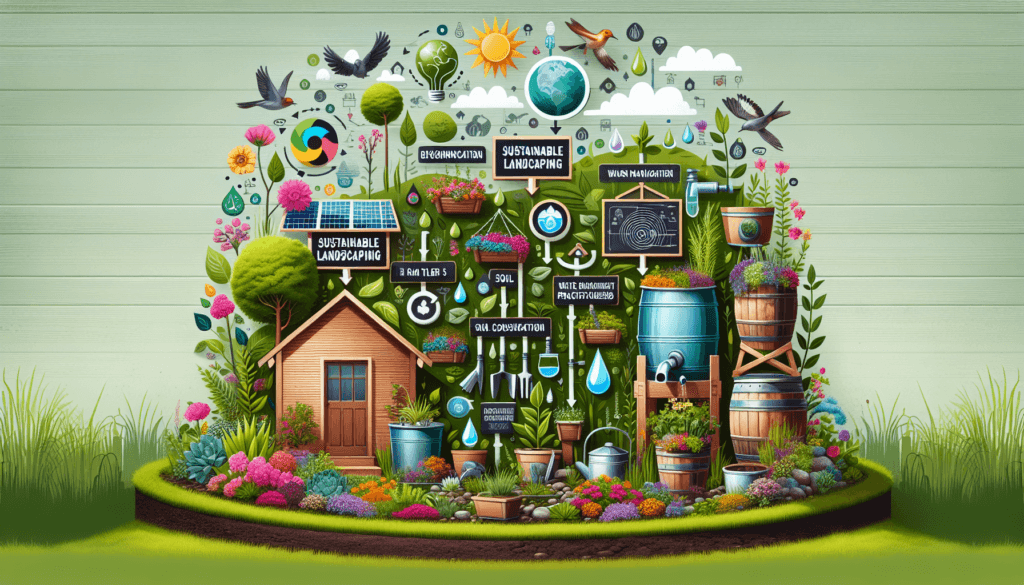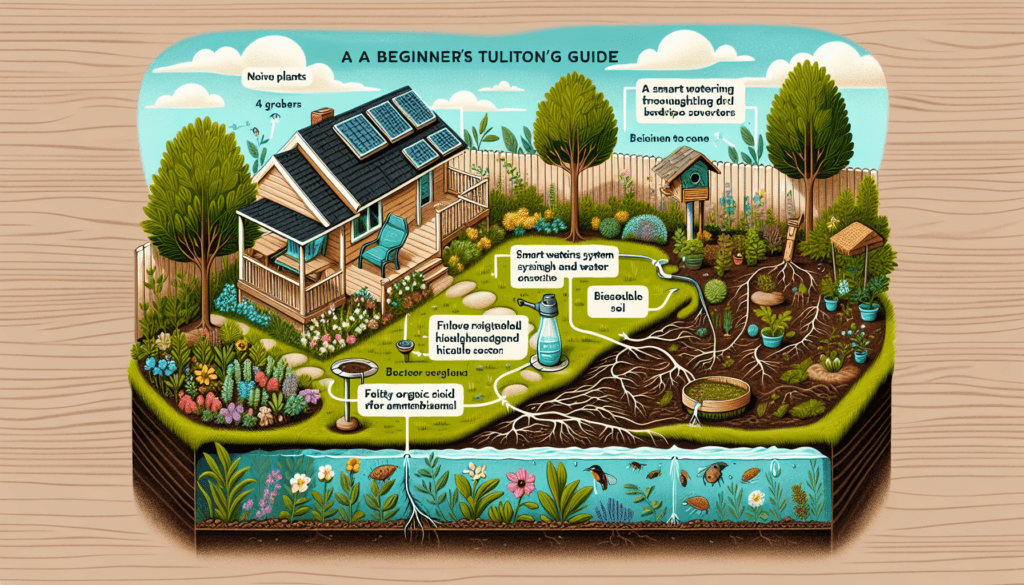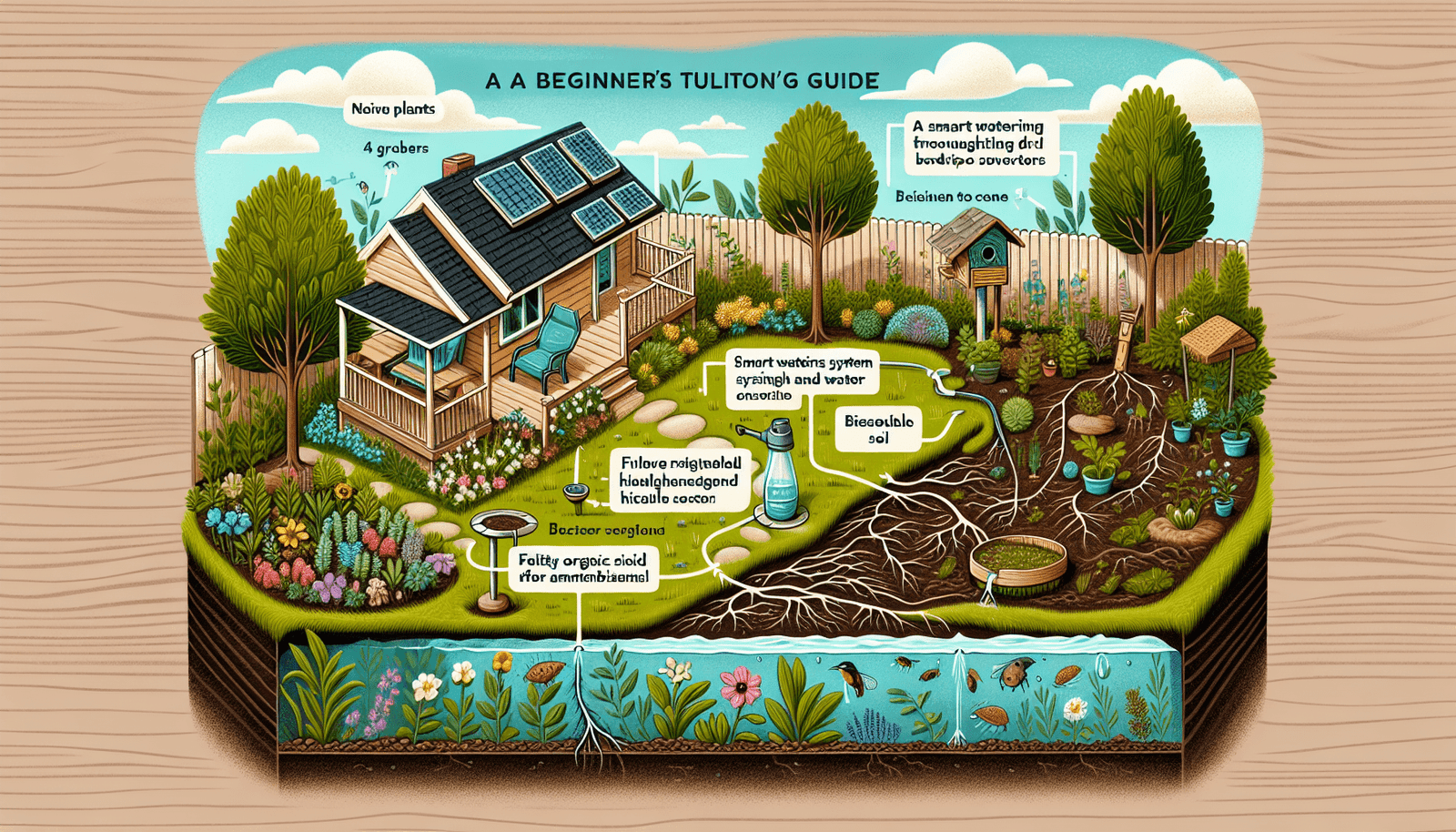Are you ready to transform your outdoor space into an eco-friendly oasis? Look no further than the “Beginner’s Guide to Sustainable Landscaping.” This comprehensive article will walk you through the essential steps and strategies for creating a sustainable landscape that harmonizes with nature and reduces your carbon footprint. From selecting native plants to conserving water and minimizing chemical usage, this guide has everything you need to know to get started on your sustainable landscaping journey. Get ready to cultivate a beautiful, environmentally-friendly garden that brings joy and sustainability to your doorstep.

Understanding Sustainable Landscaping
Definition of Sustainable Landscaping
Sustainable landscaping is an approach to designing and maintaining outdoor spaces that takes into account the environmental impact of landscaping practices. It involves creating landscapes that are not only visually appealing but also promote the health and well-being of the ecosystem they are a part of. By using sustainable practices, you can conserve resources, reduce waste and pollution, and create a more resilient landscape that can withstand environmental changes.
Importance of Sustainable Landscaping
Sustainable landscaping is crucial for several reasons. Firstly, it helps to conserve and protect natural resources. By implementing practices such as water conservation, reducing chemical use, and promoting biodiversity, you can minimize your impact on the environment. Secondly, sustainable landscaping contributes to a healthier and safer environment. By using organic practices and avoiding harmful chemicals, you create a landscape that is safe for people, pets, and wildlife. Lastly, sustainable landscaping can also save you money in the long run. By conserving water, reducing energy consumption, and minimizing the need for expensive chemical inputs, you can lower your maintenance and utility costs.
Benefits of Sustainable Landscaping
Sustainable landscaping offers a wide range of benefits. One of the primary benefits is the conservation of water resources. By implementing practices such as using native plants, grouping plants by water needs, and installing rainwater harvesting systems, you can significantly reduce your water consumption. Another benefit is the promotion of biodiversity. By creating habitats for wildlife, planting native trees and shrubs, and incorporating pollinator-friendly plants, you can attract a diverse range of species and support the local ecosystem. Additionally, sustainable landscaping can enhance the beauty and curb appeal of your property. By incorporating natural elements, such as green roofs and walls, and utilizing shade trees, you can create an inviting and aesthetically pleasing outdoor space.
Planning Your Sustainable Landscape
Assessing Your Landscape
Before embarking on your sustainable landscaping journey, it is essential to assess your current landscape. Take note of the existing plants, soil conditions, water features, and any problem areas that may need attention. By understanding the strengths and weaknesses of your landscape, you can make informed decisions during the planning and implementation stages.
Setting Your Goals
Determine what you want to achieve with your sustainable landscape. Are you aiming to conserve water, promote biodiversity, reduce chemical use, or all of the above? Setting clear goals will help guide your decision-making process and ensure that your landscape aligns with your sustainability objectives.
Researching Plant Choices
When choosing plants for your sustainable landscape, it is crucial to select species that are well-suited to your local climate and soil conditions. Native plants are an excellent choice as they are adapted to the local environment and require less water and maintenance. Research different plant varieties and consider factors such as water requirements, sun exposure needs, and compatibility with other plant species.
Creating a Site Plan
A site plan is a detailed blueprint of your landscape design. It includes the placement of plants, hardscape elements, water features, and any other design elements. By creating a site plan, you can visualize how different components of your landscape will interact and ensure that your design meets your goals for sustainability. It is also helpful when obtaining permits and estimates from contractors.

Conserving Water in Your Landscape
Using Native Plants
One of the most effective ways to conserve water in your landscape is by using native plants. Native plants have evolved to withstand local climate conditions and require less water compared to non-native species. They are also more resistant to pests and diseases, reducing the need for chemical inputs. Research native plant species for your region and incorporate them into your landscape design to minimize water usage.
Grouping Plants by Water Needs
Another water-saving technique is to group plants with similar water needs together. This practice, known as hydrozoning, allows you to efficiently water different areas of your landscape based on their specific requirements. By avoiding overwatering or underwatering certain plant species, you can optimize water usage and promote healthy plant growth.
Installing a Rainwater Harvesting System
Rainwater harvesting is an excellent way to collect and store rainwater for later use in your landscape. This can be done by installing rain barrels or larger cisterns to capture rainwater from rooftops and other surfaces. The collected rainwater can then be used for watering plants, reducing the need for tap water and conserving valuable resources.
Implementing Efficient Irrigation
Efficient irrigation practices are essential for conserving water in your landscape. Consider using drip irrigation systems, which deliver water directly to the plant’s roots, minimizing water loss through evaporation. Install weather-based controllers that automatically adjust irrigation schedules based on current weather conditions to avoid watering during rainy periods. Regularly check irrigation equipment for leaks and inefficiencies to ensure that water is being used efficiently.
Mulching and Soil Management
Applying mulch to the soil surface around plants helps to conserve moisture by reducing evaporation. Mulch also helps to suppress weeds, regulate soil temperature, and improve overall soil health. Use organic mulch materials such as wood chips, straw, or shredded leaves. Additionally, proper soil management practices, such as adding organic matter and aerating the soil, can improve water retention and infiltration, reducing the need for excessive watering.
Reducing Chemical Use
Transitioning to Organic Practices
Transitioning to organic gardening practices is a key component of sustainable landscaping. Organic practices avoid the use of synthetic fertilizers, pesticides, and herbicides, which can harm the environment and human health. Replace chemical inputs with natural alternatives such as compost, organic fertilizers, and homemade pest control solutions. By prioritizing soil health and utilizing natural methods, you can create a landscape that thrives without relying on harmful chemicals.
Implementing Integrated Pest Management
Integrated Pest Management (IPM) is a holistic approach to pest control that minimizes the use of pesticides. It focuses on preventing pest problems through cultural practices, monitoring pest populations, and using biological controls. By promoting a balanced ecosystem and creating habitats for beneficial insects and predators, you can naturally control pests and reduce the need for chemical interventions.
Choosing Natural Fertilizers
Natural fertilizers, such as compost, manure, and organic fertilizers, provide essential nutrients to plants without causing environmental harm. These fertilizers break down slowly, releasing nutrients gradually and improving soil fertility over time. Avoid synthetic fertilizers that can leach into water bodies and contribute to water pollution.
Weed Control Methods
Controlling weeds without the use of herbicides is an important aspect of sustainable landscaping. Use manual and mechanical weed control methods such as hand pulling, hoeing, mulching, and weed fabric. Regularly monitor your landscape for weed growth and address them promptly to prevent them from competing with desired plants for water and nutrients.

Promoting Biodiversity
Understanding Biodiversity
Biodiversity refers to the variety of plant and animal species within an ecosystem. Promoting biodiversity in your landscape is crucial for maintaining a healthy and resilient ecosystem. It supports the natural pollination of plants, provides habitats for wildlife, and helps to control pests naturally. By understanding the importance of biodiversity, you can make informed decisions when designing and managing your landscape.
Creating Habitats for Wildlife
Creating habitats for wildlife is an effective way to promote biodiversity in your landscape. Incorporate elements such as birdhouses, bat boxes, and butterfly feeders to attract different species. Provide food, water, and shelter through the use of native plants, diverse plantings, and strategically placed brush piles or rock piles. Avoid the use of pesticides that can harm beneficial insects and wildlife.
Planting Native Trees and Shrubs
Planting native trees and shrubs is a powerful way to support biodiversity in your landscape. Native trees and shrubs provide food and shelter for wildlife, enhance the beauty of your landscape, and help to improve air quality. Choose native species that are well-suited to your climate and soil conditions, and consider their role in the local ecosystem when designing your landscape.
Incorporating Pollinator-Friendly Plants
Pollinators such as bees, butterflies, and hummingbirds play a crucial role in the reproduction of plants. By incorporating pollinator-friendly plants into your landscape, you can attract these important species and ensure the pollination of flowers and fruits. Choose plants that provide nectar and pollen throughout the growing season and avoid the use of pesticides that can harm pollinators.
Avoiding Invasive Species
Invasive species are non-native plants that can outcompete native species and disrupt natural ecosystems. Avoid planting invasive species in your landscape, as they can spread rapidly and have negative impacts on biodiversity. Check with local resources, such as invasive species lists, to ensure that the plants you choose are not considered invasive in your area.
Maximizing Energy Efficiency
Utilizing Shade Trees
Strategically planting shade trees around your home and outdoor living spaces can help to reduce your cooling costs. The shade provided by trees can significantly lower temperatures and decrease the need for air conditioning. Choose trees that are well-adapted to your climate and plant them in locations that will maximize the shade they provide during the hottest times of the day.
Designing for Passive Solar
Passive solar design refers to utilizing the sun’s energy for heating and cooling purposes. Incorporate passive solar principles into your landscape by designing your outdoor spaces to capture sunlight in the winter and provide shade in the summer. Use elements such as deciduous trees, trellises, and pergolas to create shade and shelter from the sun when needed.
Installing Energy-Efficient Lighting
Using energy-efficient lighting in your landscape is a simple yet effective way to reduce energy consumption. Choose LED (Light Emitting Diode) lights that use less energy and last longer compared to traditional incandescent and halogen bulbs. Install motion sensors or timers to ensure that outdoor lighting is only used when necessary, further reducing energy waste.
Using Green Roofs and Walls
Green roofs and walls, also known as living roofs and vertical gardens, are excellent ways to maximize energy efficiency in your landscape. These features provide insulation, reducing heating and cooling costs, and mitigate the urban heat island effect. They also improve air quality, absorb rainwater, and provide habitat for wildlife.
Reducing Lawn Area
Lawns require significant amounts of water, fertilizers, and maintenance, making them resource-intensive. Reducing the size of your lawn area can greatly contribute to energy efficiency in your landscape. Replace unused or unnecessary lawn areas with native plants, vegetable gardens, or hardscape features to create more sustainable and functional outdoor spaces.

Managing Stormwater
Building Rain Gardens
Rain gardens are landscaped areas designed to collect and absorb rainwater, reducing stormwater runoff. They are typically planted with native plants and designed to capture rainwater from roofs, driveways, and other impervious surfaces. Rain gardens help to filter pollutants, recharge groundwater, and prevent soil erosion.
Installing Permeable Surfaces
Permeable surfaces allow rainwater to infiltrate into the ground, reducing stormwater runoff and the burden on stormwater management systems. Consider using permeable materials such as porous pavers, gravel, or permeable concrete for driveways, walkways, and patios. These surfaces help to replenish groundwater and reduce the risk of flooding.
Creating Swales and Berms
Swales and berms are landscape features designed to redirect and manage stormwater flow. Swales are shallow, gently sloping channels that help to distribute and slow down water runoff. Berms, on the other hand, are raised areas that can redirect water or create landscape features. By strategically incorporating swales and berms into your landscape, you can effectively manage stormwater and prevent erosion.
Designing Infiltration Trenches
Infiltration trenches, also known as French drains, are trenches filled with gravel or crushed stone that allow stormwater to infiltrate into the ground. They help to reduce stormwater runoff and minimize the risk of flooding. Infiltration trenches are especially useful in areas with poor drainage or compacted soil.
Improving Soil Health
Testing and Amending Soil
Testing your soil is an important step in ensuring optimal plant growth and health. Soil testing provides valuable information about the nutrient levels, pH level, and organic matter content of your soil. Based on the test results, you can amend your soil with organic matter, such as compost or well-rotted manure, to improve its fertility and structure.
Practicing Organic Soil Management
Organic soil management involves nurturing the soil ecosystem and promoting healthy microbial activity. Avoid the use of synthetic chemicals that can harm beneficial soil organisms. Instead, focus on adding organic matter, practicing crop rotation, and using cover crops to improve soil health and fertility over time.
Reducing Soil Erosion
Soil erosion is a significant problem that can lead to the loss of valuable topsoil and water pollution. Take measures to prevent soil erosion in your landscape by keeping the soil covered with plants or mulch, especially on slopes. Install erosion control measures such as retaining walls, terracing, and erosion control blankets where necessary.
Composting
Composting is a simple and effective way to reduce waste and improve soil health. Compost is created by decomposing organic materials such as kitchen scraps, yard waste, and leaves. It provides nutrients to the soil, improves its structure and water-holding capacity, and reduces the need for synthetic fertilizers. Start a compost pile or bin in your landscape and incorporate compost into your planting beds regularly.

Maintaining Your Sustainable Landscape
Proper Watering Techniques
Proper watering techniques are essential to maintain a healthy and sustainable landscape. Water deeply and infrequently to encourage deep root growth and minimize water waste. Use techniques such as drip irrigation or soaker hoses to deliver water directly to the plant’s roots and avoid wetting the foliage. Regularly monitor soil moisture levels and adjust watering based on plant needs and weather conditions.
Weeding and Pruning
Regular weeding and pruning are necessary to keep your landscape looking tidy and prevent competition for resources between plants. Remove weeds manually or using appropriate tools without the use of herbicides. Prune plants to maintain their shape, promote healthy growth, and remove dead or diseased branches. It is important to use sharp and clean tools to minimize damage to plants.
Managing Pests Naturally
Managing pests naturally is a key aspect of sustainable landscaping. Monitor your landscape regularly for signs of pest infestations and take proactive measures to prevent and control them. Use natural methods such as handpicking pests, introducing beneficial insects, and using organic pest control products only when absolutely necessary. Maintaining a healthy ecosystem through biodiversity and organic practices will naturally help to manage pest populations.
Regular Soil Testing and Fertilization
Regular soil testing is crucial for monitoring the nutrient levels and pH balance of your soil. Based on the test results, adjust your fertilization practices to ensure that your plants receive the necessary nutrients. Use organic fertilizers, compost, or natural amendments to enrich the soil and support healthy plant growth. Regularly fertilize according to the specific needs of your plants and make any necessary adjustments based on soil test results.
Finding Sustainable Landscaping Resources
Local Environmental Organizations
Local environmental organizations can provide valuable information, resources, and guidance on sustainable landscaping practices specific to your region. Contact organizations such as native plant societies, environmental nonprofits, or local extension offices for educational materials, workshops, and assistance in implementing sustainable landscaping in your area.
Landscape Architects and Designers
Consulting with a landscape architect or designer who specializes in sustainable practices can help you create a well-designed and functional sustainable landscape. They can provide expert advice, develop detailed plans, and recommend appropriate plants and materials for your specific needs and goals.
Plant Nurseries and Suppliers
Local nurseries and plant suppliers can be excellent sources of native plants and other sustainable landscaping materials. They can offer guidance on plant selection, provide information on plant care, and ensure that you are choosing species that are well-suited to your local climate and soil conditions. Supporting local nurseries also helps to promote regional biodiversity and the local economy.
Online Sustainable Landscaping Guides
Numerous online resources provide comprehensive information and guides on sustainable landscaping practices. Websites, blogs, and forums dedicated to sustainability, gardening, and landscaping offer a wealth of knowledge on various topics such as water conservation, soil health, plant selection, and eco-friendly practices. Explore these resources to learn from experienced gardeners, landscapers, and sustainability experts.


